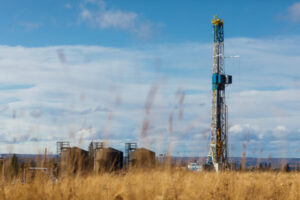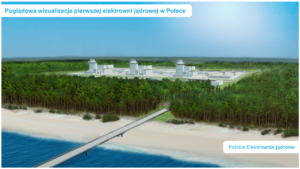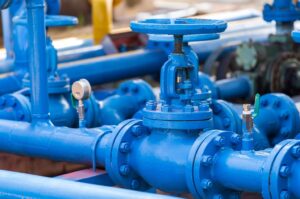If weather and other conditions do not improve, it is doubtful that both Nord Stream 2 threads will become operative until the end of 2019 – writes Mariusz Marszałkowski, a colleague at BiznesAlert.pl.
Winter on the construction site of Nord Stream 2
The winter weather is taking its toll to each of us. When it’s snowing, there are problems for snow-clearing roadmakers and energy workers working on restoring energy supplies to homes that have suffered as a result of power lines broken under the weight of snow. Public transport drivers also face difficulties, as they have to use roads forgotten by road builders. Winter often surprises services responsible for maintaining proper road conditions. An unpleasant aura of is a problem also for the average Kowalski, who after the night’s turmoil is forced to clear the sidewalk of the snow in front of his home or the driveway to the garage. When refrigerators or other basic household appliances refuse to obey next hours or consecutive days, discomfort is also burdened with waiting at home for the resumption of power supplies.
The situation is similar in the Baltic Sea. However, „winter” statistically starts here much sooner because its first symptoms appear at the end of October. In the case of the sea, the problem is not snow drifts, broken power lines, or the temperature falling well below 0 ° C. Winter in the Baltic means visibility, heavy rainfall or snowfall, glaciation of some parts of the basin and storms limited by dense fog. It is the latter that pose the greatest threat to offshore shipping, fishing and construction work on various installations of the offshore segment.
Storms are a weather phenomenon that occurs throughout the Baltic Sea year-round. Most often they appear between November and March, when low-pressure systems move on different tracks. In the case of the Baltic Sea, this movement usually takes place from the west to the east. However, not every wind at sea is the same as a storm. According to the commonly accepted definition of metrological services in Poland, in order to talk about a storm, the wind speed must exceed at least 17,2 m/s and persist for at least one hour.
However, is only the storm causing problems? No. For the construction of an installation such as the Nord Stream 2 pipeline, the problem is also the wind, the speed of which does not meet such requirements to classify it as a storm. Problems posed by such winds result from the hardware and logistic specifications of the constructed installation.
Pipe-Layer-Vessel PLV units use remotely operated vehicles (Remotely Operated underwater Vehicles ROV) on their equipment during operation. They are used to monitor the state of joints between individual pipes, to assess whether pipes are arranged in accordance with the planned route and whether they need to be adjusted and also to detect direct hazards to the pipeline being built. ROV also remain indispensable for the Abandonnment and Recovery (A/R) procedure, i.e. in the case of interruption of work on a given section (eg changing the unit used for laying, bad weather conditions or a major failure), a special plug is mounted on the pipeline tip to allow the pipe to be lowered bottom, as well as the subsequent extraction of pipes using a specialized crane. In this way, the extracted pipes are placed on the so-called Stinger, i.e. a ramp installed on the decking unit, whose task is to safely leave the connected pipe sections back to the bottom during further work.
Industrial ROV systems used in the construction work of offshore installations are mostly adapted to work in weather conditions in which the wind does not exceed 15 m/s, and the wave height is not greater than 2 m. For the safety of ROV operation, the latter is particularly important value, because waves of higher altitude can cause emergency situations in which the vehicle may be damaged, and there is even a high probability that the cable connecting the ship to the vehicle will break, which consequently means the loss of very valuable equipment. In addition, controlling the vehicle underwater under such conditions is much more difficult, which requires a lot of precision of the operator and a suitably equipped vessel. More and more popular, especially in ships operating in the area of the Norwegian Sea, is the use of special compensators mounted on cranes, designed to control the underwater vehicle in waves exceeding 3 meters.
The wonderful eleven
Another very important hindrance resulting from strong winds and high waves are logistic operations performed by the so-called Pipe Supply Vessels (PSV), ie units that supply pipes and other required supplies from one of the four logistics centers designated for the NS2 project (Mukran in Germany, Karlshamn in Sweden, Kovehar and Kotka in Finland) on board of PLV units. In accordance with the current state (they are chartered for a specific period of time, the presence of a given unit may be related to the current demand for a specific number of such vessels) PSV functions for the NS2 project are 11 entities owned by 6 entities:
Normand Naley
Sea Supra
Solstad Offshore
Standard Princess
Standard Provider
Standard Supplier
Fletcher Group
Havila Crusader
Havila Shipping
Solvik Supplier
Vestland Offshore
Symphony Provider
Symphony Performer
Symphony Shipping
Alegria
Fortress
Allseas
All of these units work 24 hours a day, 7 days a week, to successfully and without interruptions deliver between 80 and 120, 12-meter pipes to the decking units of pipelines. After loading the load on the deck (which takes about 5 hours) they go to the construction area, then using the horizontal propulsors, the side boards are positioned with the PLV unit, which draws the pipe to the deck using special cranes. Unloading takes between 5 and 7 hours, which requires a long time to stay on the parallel course, at a constant speed in relation to the building unit. In the case of logistic units, wind force above 15 m/s makes it difficult to maintain the appropriate course and speed relative to the PLV unit. In contrast, when the wind speed exceeds 20 m/s, it becomes dangerous for both units, which results in the suspension of pipe delivery until the aura calms down enough to make it safe to move the cargo from logistic units to the unit responsible for laying the pipeline.
Storms
So far, due to the strong storm, the works required to be stopped at least 3 times on the German section (the Greifswalder Bay area) in which Castoro Dieci (C10) and Audacia operated. The interval was each time between 48 and 72 hours for both types of units. Work on the Finnish section was halted twice, where the breaks were between 30 and 80 hours and concerned Solitaire and Pioneering Spirit units. The last example of a strong storm stopping both units was the New Year’s storm with a strength of up to 10 degrees on the Beaufort scale. It touched the area from the waters of the Gulf of Finland to the southern areas of the island of Bornholm. It lasted from December 31, 2012 to January 3, 2019.
The break resulting from unfavorable weather was, however, much more, but not all resulted in a complete suspension of work, but only a temporary stoppage of laying the gas pipeline. It has been observed that such breaks usually last between two and five hours.
Estimating, due to the suspension of work because of weather conditions, Nord Stream 2 has been halted for at least several hundreds hours, and even one-third of the length of the gas pipeline has not yet been arranged (information provided by NS2 AG regarding the arrangement of approximately 400 km of pipeline for „A” thread and „B” thread, not just one of them). Precise determination of the number of „lost” man-hours is not possible due to the lack of such information provided by the investor. This remains understandable, because it would show the real scale of delays and losses related to this. The weather is also a problem for the rotation of crews of PLVs taking place using helicopters once every two weeks.
These breaks have not only a negative impact on the chances of completing the plan, so that both Nord Stream 2 threads will be handed over until the end of this year, but also raise the cost of the project itself. Every day of stopping work brings several hundred thousand euros of losses.
It is possible to calculate this on the basis of the level of fuel consumed by the units involved in the construction (11 PSV units, 2 PLV units, 2 Offshore Construction Vessel units – that is, units supporting directly PLV units in construction eg testing the seabed or laying special concrete mattresses in places NS2 intersections with other undersea installations) and costs of charter of PSV units as only two vessels transporting pipes are the property of the main contractor of the project, Allseas, while the remaining 9 require charter for a specified period. Contract values are not made public, but on the basis of data presented by brokers, the spot costs of charters vary between 7 and 11 thousand euros per day. It is impossible to calculate other costs such as equipment consumption, supply of spare parts, compensation of crews (a total of over 1 200 people) meals or port fees, as these data are not usually given and may vary depending on the season, port or current construction site.
Due to its size, relatively shallow and closed Baltic Sea is often called contemptuous by malicious and unaware „ponds”. The Baltic Sea, however, remains an extremely heavy reservoir due to the high ship traffic, severe and unpredictable weather, an uneven bottom, and many explosives and chemical munitions sunk after the Second World War. It remains a difficult reservoir for both shipping and constructors of all offshore projects, as the Nord Stream 2 investor is now also experiencing.
Not without reason, therefore, the original schedules provided for the start of construction works on the Danish-Swedish section for the second quarter of 2018. Unfortunately, for Nord Stream 2 AG, waiting for a construction permit by Denmark resulted in a forced adjustment of the schedule and a change of the initial construction site. The aftermath of this is the necessity to conduct construction works on the open Baltic Sea in the season that is least suited to this.
The delay remains on the horizon
So what are the forecasts for the construction of Nord Stream 2 in 2019?
If the composition of PLV units involved in the construction does not change, it is doubtful that both threads A and B will be operatively used until the end of 2019. The construction unit should be joined by the MRTS Fortuna unit, which is responsible for the construction of a 26 km gas pipeline in the Russian shelf waters. The commencement of works on this episode was dated December 2018, but this did not happen.
With an optimistic assumption of an average construction rate of 8,4 km per day for both units – Solitaire and Pioneering Spirit, the location of the remaining approx. 2,000 km of both strands of Nord Stream will take about 250 days. However, this value will also be difficult to achieve given the random situations such as bad weather conditions or unexpected and serious failures, as well as the planned withdrawal of Pioneering Spirit units in the spring of 2019 beyond the Baltic Sea.
The withdrawal of the unit is related to its commitment to the installation of two drilling platforms in the Johan Sverdrup oil field in the North Sea.
According to estimates, the stop of work for this ship may be at least 3 weeks, which will have a significant impact on the construction of the remaining Nord Stream 2 sections. It is also worth to follow the construction progress at Nord Stream 2 in the context of the positive environmental approval issued by the Mining Office in Stralsund regarding among others AWTI (Above water tie in) connections. The AWTI method is based on combining two separate sections of pipelines with a special barge that lifts both sections above the surface of the water, where it aligns them and welds together. Connections in the German zone are planned on kilometer sections of 10 KP – 17 KP (at the border of the German EEZ). Carrying out connections in accordance with the issued permit is only allowed between 15.05 and 31.10, which means that the window for the possibility of connecting pipes between the German and Danish zones lasts only slightly over 5 months.
If the Danish authorities refrain from issuing a decision on the permit to carry out the pipeline through their territorial waters, or alternatively, through the Danish EEZ to at least August, it may mean that the entire investment can not be completed by the end of this year.
The mere approval of the construction by the Danish authorities does not automatically mean the possibility of starting work on the Danish section. This stage requires a series of pre-pipe operations, such as exploring the gas pipeline route or rock placement to stabilize the places through which the pipeline will run. The success of Nord Stream 2 in 2019 depends on the decision of the Danish government, environmental approvals and… weather.








